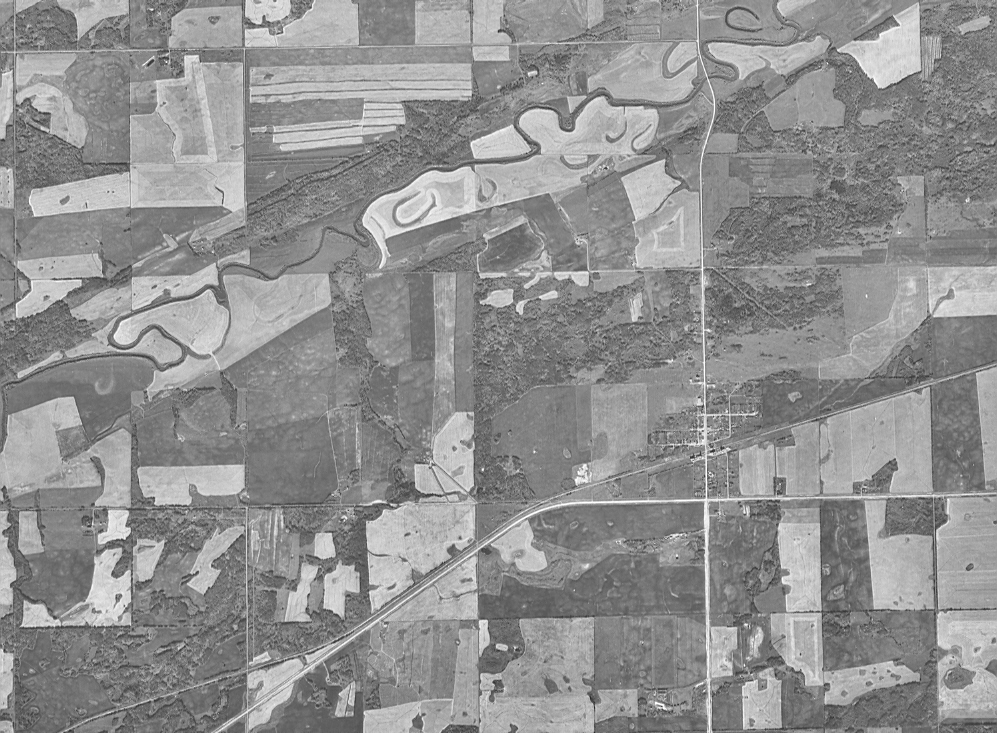In 1908 the rail line extended westward connecting the villages of Benito and Pelly. A year earlier Ukrainian settlers were granted homesteads at ten dollars per quarter-section at rail's end. Doukhobor families had arrived ahead of them in 1899, settling in communes and colonies. There were thirteen communes by name in the Thunder Hill colony, some larger than the village of Arran. In 1907 a law was enacted requiring Doukhobor settlers to take oaths that would lead to citizenship and private land ownership, which most of them declined to do. Their lands were ruthlessly confiscated and offered for public sale. Demise of the communes resulted, and mass exodus began to the Kootenays in British Columbia. It was followed by an unprecedented land rush for the vacated farms that were repossessed and released again as homesteads.
The Doukhobor farmers had built a grain elevator to move grain from the rich croplands to markets in Winnipeg. It was later acquired by the Consolidated Grain Company. A general store, stocked from a boxcar full of supplies "imported" by rail from Ethelbert, was established by storekeeper John McLean (1857-1935) in 1910. He had previously mastered a fluent Ukrainian tongue while living in Dauphin. His son Ross, whose illustrious career took him to the top of Canada’s diplomatic ranks, created the National Film Board as his legacy. The landscape changed as the years went by. The forests gave way to grain fields, and roads that wound through the meadows or curved around marshland became straight lines trimmed with fences. The historic tribal ways of fur-trading by the Ojibway had come to an end.
The young ambitious families required learning for their offspring. It was time for schools. The first to be built were Racing Lake in 1909 and Pasieka (beehive) School in 1910. Other name-worthy one-room schools quickly followed in districts known as: Vesna (spring), it was built in May 1912; Beaver Plains and Sunny Isle in 1913; Kobzar (musician, also classic literary works of Taras Sawchenko, bard of the Ukraine) in 1915; Osin (autumn, built in the fall); Podolia (lowlands); Bearshead, Poplar Bluff, Whitebeech (Mr White and Mr Beech), Border Road, and in 1918 Watson Creek. The first classroom at Arran was opened in 1915. In attendance were twenty-two students taught by David Morris and Agnes Terry. The school closed at 4 pm on June 30, 1994.
The prairie village of Arran, initially known as Racing Lake and renamed in 1916 after the Isle of Arran in Scotland, is located in the Municipality of Livingston midway between Benito and Pelly. It was incorporated in 1914; its eastern half on a land-grant owned by the Canadian Northern Railway and western half on land homesteaded by John Popoff. Farm implement dealer W J McKeen was its first overseer. The municipality was named after Fort Livingstone 10 miles to the west, a one-time capital (1876-1877) of the Northwest Territories following a move from Fort Garry. The fort was also a base for 185 red-coated police officers and their horses. The seat of government that was infested by garter snakes was subsequently relocated to Battleford and then to Regina in 1882.
In its heyday Arran boasted the giant Stewart Lumber Company that milled logs floated downstream on the Swan River from lands and forests cleared for farming. Support services were established that included: an electrical power plant known as the power house, a machine shop and two blacksmith shops, implement dealers, a bank, a credit union, five general stores, a four-room school, four grain elevators, four filling stations, two automotive service stations, a weekly newspaper (1922-1946), offices of the Municipalities of Livingston and St Phillips, telephone exchange, hotel, law office, Friday-night movie theatre, boarding houses, butcher shop, stockyards, egg-candling station, two restaurants, harness and shoe repair shop, livery barn, community and sports facilities, a clandestine casino for midnight gamblers, a fire hall, and a church bell heard for many miles that filled people's hearts with trust and joy. Ringing the bell three times at twilight sounded a death knell.
The Ukrainian Catholic Church of St Peter and St Paul was the first church, and was built in the Vesna district in 1910 on 1.5 acres of homestead land donated by Phillip Chorneyko. The founding members were Prokop Hryhoryshen, Phillip Chorneyko, Emil and Kost Filipowich, Andrew Horocholyn, John Hrabarchuk, Sam Kinaschuk, Jacob Prokopchuk, Anton Sikorski, and John Yurchyshyn.It was rebuilt in 1961. It was followed by the Church of St John the Baptist in Arran, built in 1918. Following a disastrous fire, it was built anew in 1925 at a cost of $2300 and devoted help from volunteer tradesmen. The priest's circuit included churches at Pelly, Whitebeech and Maybridge. The Parish hall was constructed in 1935 nearby.
A community hall known as the Ukrainian People's Home was built in 1919. It was the scene of many church functions, drama nights and a wide variety of festive gatherings. School concerts featured excited students acting their roles garbed in crepe paper and make-up as they were transformed into fairies, angels, shepherds, Maypole dancers, and evil-looking monsters. The Holy Ascension Ukrainian Church in the Kobzar district, now a designated Saskatchewan Cultural Site, was completed in 1933. It's located six miles south of Arran on two acres of homestead land donated by Vasyl and Euphemia Fedchun. The Ukrainian Orthodox Church of the Holy Ghost was built in Whitebeech in 1933.




